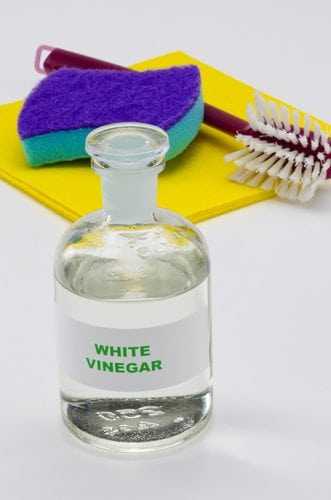 WILL YOUR MARBLE & TRAVERTINE CLEANER MAKE YOUR LIFE EASIER, SAFER AND HEALTHIER?
WILL YOUR MARBLE & TRAVERTINE CLEANER MAKE YOUR LIFE EASIER, SAFER AND HEALTHIER?
OR WILL IT COST YOU THOUSANDS?
Marble is a gorgeous, natural looking surface characterized by elegant swirling colors and an elegant finish designed to accent a beautiful home. Travertine is but one form of marble, most often displaying a tan to brown color, with spots of cream. How you care for your travertine will make the difference between pride and horror. Choose the wrong cleaner and a $10 investment could cost you thousands; not to mention the shocking realization you did it yourself and the frustration of realizing that no amount of “cleaning” will remove the dullness, swirls, spots and spill marks burned into your floor. Now you need a restoration. The restoration service industry’s phone calls typically surge following slick TV ads promoting effective calcium and hard water removing cleaners, or all purpose tile cleaners. The only difference is how fast they will destroy your finish. The good news is this mistake can be fixed, but not without a restoration. All because the wrong cleaner was used.
A quick fact: your marble and travertine floors are made of the same material that is deposited on the surface as “hard water stains” or “calcium deposits,” Calcium Carbonate. While a knowledgeable restoration expert can remove these deposits without damaging the original stone, the cleaning industry will promote or recommend various acidic concoctions to chemically remove these deposits, and in doing so will also dissolve pits into your finished floor surface. A beautiful floor can be converted into a white-etched, streaked mess within one application of a hard water remover or gradually over time with the use of vinegar or a to a duller finish with a tile cleaner. Like a dieter watching calories, it pays to read the label and avoid anything that contains a hint of acid- or does not specifically tout itself to be marble-safe.
IF YOU WANT CLEAN, YOU NEED TO BE ABLE TO REMOVE OILS
Water, while safe, fails to remove the other enemy, oil. Oil collects on floors from a variety of sources. We walk it in: bare feet and pet pads deposit it, we splatter it as we cook, and deposit it with each spill. What is clear is that dirt by itself will not stick to a floor, it needs an oil base to act as its adhesive. Remove the oil and the floor can be cleaned with a dry duster. much easier than pulling out the mop bucket, water just won’t do it.
Neither will an acidic cleaner like vinegar, or even a solvent cleaner. They ride on top of the oil and do little but move it around. A surfactant cleaner however is different, its half water-loving half oil-loving, nature allows it to surround the oil so that it cannot see the water while allowing the oil to be carried away by the water. It also has the benefit of doing the same with acids. So instead of simply diluting and spreading the damage when we wipe up with water, we can effectively surround and neutralize the acid, halting its damaging effects.
MARBLELIFE developed surfactant cleaning technology in response to a recognized gap in the market between water, vinegar, tile cleaners and calcium removers. Optimized over years as a marble cleaner, it now offers a myriad of additional benefits. By removing persistent surface oil contamination, it enhances floor safety by measurably improving anti-slip performance. In fact, in a study of anti-slip treatments, more than 80% of the benefit was captured by simply using the right cleaner- something that could be done without any further treatments. When it comes to disinfecting do you want to kill the bugs and leave the carcass? Or do you simply remove everything on the surface? Optimized for ease of use, it will remove oil without streaking, making it suitable for far more than its initial mission as a marble and travertine cleaner.
When it comes to cleaner selection, it’s simple. Get it right, and you get the benefits of having made an informed decision. Get it wrong, and the costs can reach the thousands; as the only way to remove acid damage is to grind the entire marble tile down to the depth of the deepest damage.
THE WRONG CLEANER WILL REMOVE YOUR SEAL
Acids have another dastardly feature. They reverse the chemistry of your stone sealer, allowing it to be washed away over time and leaving your stone and travertine susceptible to staining. You don’t need to get anxious when your little visitor is walking across the floor with a blue kool aid- if your floor is properly sealed, that is. Sealing is like an insurance policy. You rest easy when you have it and have reason to be concerned when you don’t. Use of an acidic cleaner can remove the entire seal in one application. We know this because we utilize acids to remove grout sealers before treating the grout to restore its color, and we can do so in one application. Therefore…so can you.
SEALING YOUR FLOOR…AND WHY YOU MAY HAVE TO DO IT AGAIN.
The second myth we have to manage is the need to seal your floor. Marble is highly porous. In its natural state it will absorb water on contact, darkening as it does. The stone was likely sealed on installation. However, sealers are not permanent. In fact, acid has the nasty habit of reversing the reaction the sealer went through when applied, allowing it to be washed away. So applying an acid cleaner will literally wash away the sealer. Acid spills such as tea, coffee or juice will do the same thing but on a spot basis. Once destroyed, the surface is open and susceptible to being stained. Now that blue Kool Aid in that little one’s hands becomes a source of anxiety. In fact, anything with a dye could create a problem. Once stained, you cannot guarantee it can be removed. You are better off applying an ounce of prevention so you can sleep well and unconcerned. Stone should be sealed every other year. This is your insurance policy, and like all such policies, you are overjoyed to have it when you need it, but regret not getting it when you really need it.
So a non-acidic surfactant based cleaner and a penetrating sealer are the keys to caring for your marble and travertine. Select an appropriate offering and your floor will be easier, healthier and more beautiful. Choose wrongly, and you will have a dull, slip-prone, frustrating surface that is going to cost you a pretty penny to restore.
MARBLELIFE has been formulating, optimizing and developing Marble, Travertine, Granite, Tile and Concrete Cleaners, services and care processes for more than 25 years. Throughout this time, we have become the largest stone restoration company in North America. For more information visit us at MARBLELIFE Product page or MARBLELIFE website



 Stone surfaces are in high demand these days not just for their durability, but for their beauty as well. With such unique and beautiful counter tops, floors, and outdoor surfaces, it’s essential to use cleaners made especially for those surfaces. Grocery store cleaning products seem inexpensive, but they are mostly acidic and can cause damage to your natural stone surfaces. Tile and grout needs special care as well.
Stone surfaces are in high demand these days not just for their durability, but for their beauty as well. With such unique and beautiful counter tops, floors, and outdoor surfaces, it’s essential to use cleaners made especially for those surfaces. Grocery store cleaning products seem inexpensive, but they are mostly acidic and can cause damage to your natural stone surfaces. Tile and grout needs special care as well. 
 We face an interesting and likely bombastic election season in front of us. Regardless what we hear and what we believe, the one thing we can all appreciate is …clean.
We face an interesting and likely bombastic election season in front of us. Regardless what we hear and what we believe, the one thing we can all appreciate is …clean.

